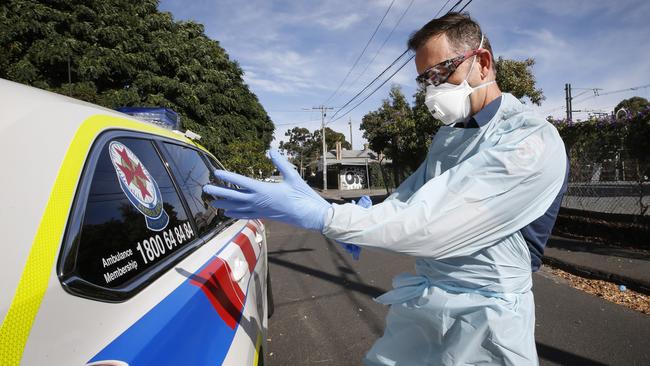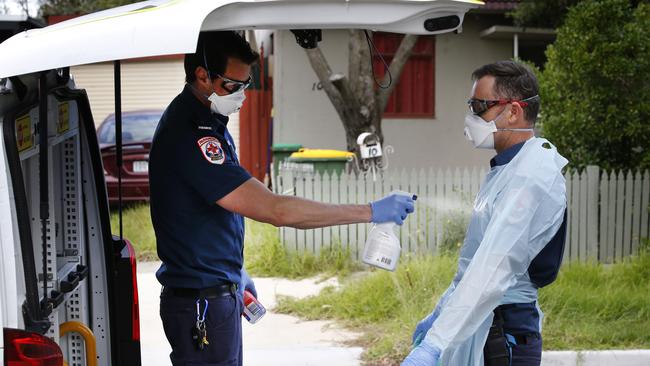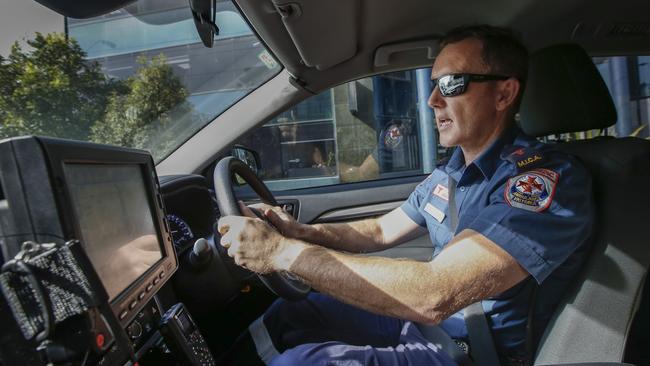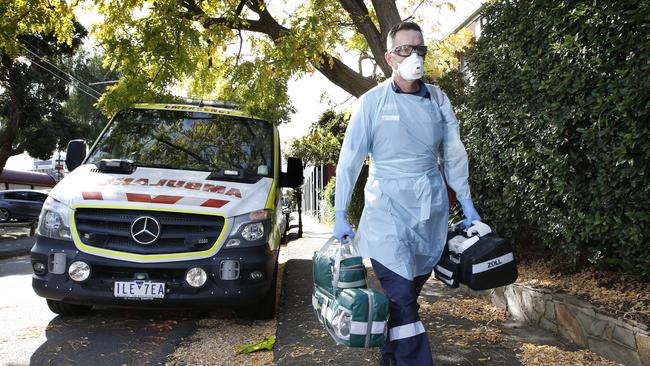Paramedic reveals how COVID-19 has impacted way they work
From how they perform life saving treatments to adopting PPE that belongs in sci-fi movies, coronavirus has transformed the way paramedics carry out their important work. Here’s a real life look at how ambos have continued to help our most vulnerable.
VIC News
Don't miss out on the headlines from VIC News. Followed categories will be added to My News.
Veteran MICA paramedic Cullen Hamilton starts preparing for work long before he’s called out on his first job.
The dangers of coronavirus contamination mean paramedics now need to be clean-shaven and cannot wear watches or any other jewellery, including wedding rings.
As he begins his shift, Mr Hamilton’s personal belongings are put into plastic pockets inside his bag so they are not exposed to anything he may encounter.
His phone — which contains crucial clinical practice guidelines — is placed in a sealed plastic sleeve in case it is required at a medical scene.

In stations shoes must be removed, radios placed on designated pads and nothing can enter communal areas that has had any chance of being exposed at a job scene.
Then, before stepping into his ambulance, the 20-year paramedic has to undertake a health and wellbeing checklist, including checking his temperature to ensure he is symptom-free.
When he’s called out to a woman lying unresponsive on an overgrown nature strip, he’s part of a small blue and faceless army rushing all around her.
As he parks, turns off his sirens and prepares to join the fight to save the desperate woman’s life, Mr Hamilton must first safeguard himself from COVID-19.

The methodical routine begins: wash hands with alcohol; put on latex gloves; wash the gloves with alcohol; put on goggles; choose the most protective mask and put it on; decide which of the two gowns is needed; put it on and tie up its blue plastic straps; put on second pair of gloves; and, finally, attend to the patient.
It’s now impossible to tell the MICA paramedic from any of the other emergency workers covered from head to toe in blue and trying to restart the woman’s heart.
Welcome to a day in the increasingly complex life of a pandemic paramedic.
“We haven’t used PPE (personal protective equipment) like this ever before — now it is our standard practice,” he says.

“COVID-19 has added a another layer of complexity, anxiety and stress to all jobs, not just positive patients.
“We are getting a handle on it a bit better but, each time you go a new type of case where you haven’t been with PPE before, it is number of new things.”
As a Code 1 emergency — a woman in cardiac arrest after a heroin overdose — all available emergency services in the area have rushed to the Heidelberg scene.
There are four different types of ambulance, a fire truck and a police car gathered by 1.35pm.
But it is impossible to know who belongs to each vehicle while normal uniforms are covered by matching blue protective suits.
It’s not that the unconscious patient is known have COVID-19, but her background is unknown and the treatment needed to restart breathing or intubate her carries a huge risk of contamination.
Like about 700 Ambulance Victoria call-outs each day, the only safe way to save the patient and those around her is to assume she has coronavirus and spend as much time mitigating its risk as getting her breathing.

By 1.45pm the paramedics have done just that.
The woman is breathing with the help of oxygen being pumped into her lungs — as well as the new requirement of a mask placed over her nose and mouth to prevent droplets being blasted into the air. As she heads to hospital, Mr Hamilton and the other emergency service workers stand at the back of their vehicles and begin the long process of “doffing”.
With yellow bags plastered with “hazard” warnings between them, the crews slowly begin removing each item, place them in the bag for destruction and dousing themselves in alcohol wash in-between each step.
Removing the PPE is the most important step in the pandemic process.
Touching any exposed surface would render all the other efforts in vain and expose Victoria’s health system to an outbreak.
“It is not something you rush. It has to be controlled and measured, how you remove it,” Mr Hamilton says.


“The doffing of PPE in particular is longer and adding time.
“Crews are held up more at hospitals and after jobs correctly doffing PPE.”
DEALING with COVID-19 goes much further than the PPE the public can see. On the passenger seat beside Mr Hamilton is a playbook for beating coronavirus – Ambulance Victoria’s operational guide for dealing with COVID-19, version 19.
The fact the guidelines have already been redrafted 19 times in just six weeks tells you everything about how rapidly the service and its paramedics are having to adapt to the new dangers.
“In the first four weeks, the testing criteria was changing daily and it was hard to keep up,” Mr Hamilton says.
“We have changed it now so the main thing we have to think about is. ‘What PPE are we wearing to a job?’
“Now we have got prescribed PPE for the types of procedures we are doing and the conditions that we’re seeing.”
Lifesaving treatments have also changed.
Handheld ventilation bags can no longer be used to pump oxygen into a patient because they turn droplets into aerosols that escape the mouth. Instead, crews are having to intubate – or place a tube directly into their lungs – much sooner.
Otherwise, nasal prongs can be used to provide oxygen via the safer option of a nose, but only if a P1 mask is secured over the top.
Paramedics have also had to stop using ventolin for asthmatics, instead giving them adrenaline shots which can do the same thing.
“All those little things add up. The cogs are turning a little bit slower,” Mr Hamilton says. “There certainly is a little bit of uncertainty and anxiety among paramedics and first responders.

“It is not necessarily from the virus itself, it’s because of the large amounts of changes to work practice in the last six weeks.
“When you have such rapid and constant change it can be a bit destabilising.”
As he weaves in and of traffic, around trams and through red lights with siren blaring and lights reflecting off the shop fronts flashing by, more details of the cardiac arrest patient come across the dispatch.
Not only does he have to think about the treatments required as he drives, Mr Hamilton now also needs to runs through the new COVID-19 measures he is fast adapting to.
“There is droplet contact so I need to put on a gown and wear a P2 mask,” he says aloud to himself.
“It is another thing to think about.
“We are capable of doing this, but it adds to the cognitive load.
“We are going to be doing this, at this level of PPE, until there is a vaccine.
“The last six weeks have been a sprint, now we are in a marathon. This is (now) our standard practice and we have to adjust.”
